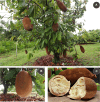Genomic decoding of Theobroma grandiflorum (cupuassu) at chromosomal scale: evolutionary insights for horticultural innovation
- PMID: 38837946
- PMCID: PMC11152179
- DOI: 10.1093/gigascience/giae027
Genomic decoding of Theobroma grandiflorum (cupuassu) at chromosomal scale: evolutionary insights for horticultural innovation
Abstract
Background: Theobroma grandiflorum (Malvaceae), known as cupuassu, is a tree indigenous to the Amazon basin, valued for its large fruits and seed pulp, contributing notably to the Amazonian bioeconomy. The seed pulp is utilized in desserts and beverages, and its seed butter is used in cosmetics. Here, we present the sequenced telomere-to-telomere genome of cupuassu, disclosing its genomic structure, evolutionary features, and phylogenetic relationships within the Malvaceae family.
Findings: The cupuassu genome spans 423 Mb, encodes 31,381 genes distributed in 10 chromosomes, and exhibits approximately 65% gene synteny with the Theobroma cacao genome, reflecting a conserved evolutionary history, albeit punctuated with unique genomic variations. The main changes are pronounced by bursts of long-terminal repeat retrotransposons at postspecies divergence, retrocopied and singleton genes, and gene families displaying distinctive patterns of expansion and contraction. Furthermore, positively selected genes are evident, particularly among retained and dispersed tandem and proximal duplicated genes associated with general fruit and seed traits and defense mechanisms, supporting the hypothesis of potential episodes of subfunctionalization and neofunctionalization following duplication, as well as impact from distinct domestication process. These genomic variations may underpin the differences observed in fruit and seed morphology, ripening, and disease resistance between cupuassu and the other Malvaceae species.
Conclusions: The cupuassu genome offers a foundational resource for both breeding improvement and conservation biology, yielding insights into the evolution and diversity within the genus Theobroma.
Keywords: Amazon basin; bioeconomy; cupuassu; fruit pulp and seed development; gene loss and retention; genome evolution; plant secondary metabolites; positive selection.
© The Author(s) 2024. Published by Oxford University Press GigaScience.
Conflict of interest statement
The authors declare that they have no competing interests.
Figures








References
-
- Cuatrecasas J. Cacao and Its Allies: A Taxonomic Revision of the Genus Theobroma. 1964; Washington, DC: Smithsonian Institution.
-
- The Angiosperm Phylogeny Group . An update of the Angiosperm Phylogeny Group classification for the orders and families of flowering plants: APG IV. Bot J Linn Soc. 2016;181:1–20. 10.1111/boj.12385. - DOI
-
- Freitas ÍR, Pirani JR, Colli-Silva M. Cacau para quê? Levantamento bibliográfico sobre os usos materiais e simbólicos das espécies de cacaus do brasil. Ethnoscientia. 2023;8:127. 10.18542/ethnoscientia.v8i1.12940. - DOI
-
- Garcia TB, de V Potiguara RC, Kikuchi TYS, et al. Leaf anatomical features of three theobroma species (Malvaceae s.l.) native to the Brazilian Amazon. Acta Amaz. 2014;44:291–300. 10.1590/1809-4392201300653. - DOI
Publication types
MeSH terms
Grants and funding
LinkOut - more resources
Full Text Sources
Miscellaneous

